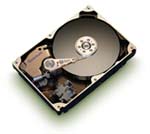For any business your data management is critical to your day to day operations.
Loss of data can be a serious problem. When a hard drive
or other storage media crashes or stops working a professional,
cost effective and prompt data recovery service is required

Data recovery can be from desktops, laptop / notebook computers, DVDs, CDs, etc.
Here are links to some great Services:
How To Prevent Data Loss
Prevention is sometimes better than cure, data loss can be
devastating to any business, but recovery is much easier if a
contingency plan is formulated before the event, rather than after.
Forget about motherboards, processors, memory modules and graphic card,
the most important part of any computer system is the data it holds.
Should data loss occur, it could take ages to re-install those bloated applications,
let alone any vital files and documents. But time is money,
and in today’s business environment the information and
data a company stores is often the basis of its competitive advantage.
With the temporary loss of such data, a company can quickly
lose its cutting edge.
To lose it permanently will almost certainly bring about severe disruption;
so much disruption that many companies will never recover from such a loss.
While disk drives are more reliable than they have ever been, disk failure is not the only
reason for misfortune to strike. Apart from fire, flood, and other “acts of God”,
the system administrator has to look out for a multitude of
potentially disastrous possibilities, including the loss of data
from computer virus, human error, theft, and deliberate vandalism.
Have A Recovery Plan
How quickly a company gets up and running after such a “disaster” depends largely on the precautions it has taken beforehand. After all, it is far better to formulate a recovery plan before the event, rather than later. The type of recovery plan chosen will depend not only on the level of failure or downtime the company is prepared to accept, but on how much money it is willing to spend on a recovery strategy.
A real-time fault-tolerant system – preferably achieved by remote server clustering – should ensure continued operation after failure occurs. If a server were to go down, a real-time fault-tolerant system would automatically switch to another server or system.
No data would be lost, and the least amount of disruption would occur.
But real-time fault tolerance is not cheap, and neither is it always perfect. Typically, when a file is deleted from a real-time fault-tolerant server, the server cluster also deletes the file.
Recovery, therefore, is hardly “real-time” because it usually takes several minutes to restore the file from its backup set. Moreover, the file may not be identical to the lost file; it could be hours, or perhaps even days old.
The Last Known Good feature can also be a quick recovery tool. It works because most successful boots are cloned to the Last known- Good entry in the system registry. Thus, hitting the space bar when your PC/Laptops boots will invoke the Last Known Good configuration, effectively ignoring the new driver or system settings responsible for having caused the problem.
More recovery options can be found in the System Properties Startup/Shut down tab, accessed by clicking on the Control Panel system applet. For example, the system can be set to reboot immediately after a crash and without the need for any manual intervention.
Thanks the Techstore Team
